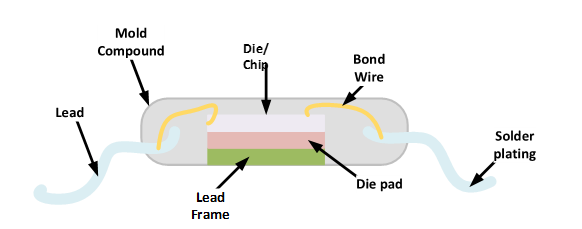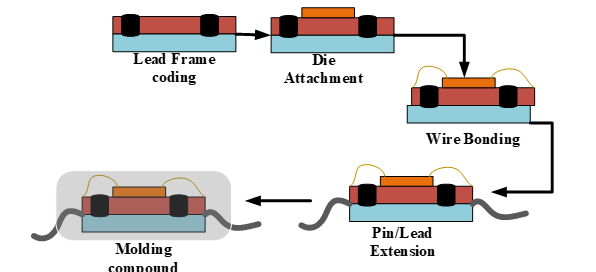Hướng dẫn cuối cùng về gói QFP
In semiconductor technology, packaging with compact size and high performance is in high demand. Among several discovered semiconductor packaging technologies, Quad Flat Pack (QFP) has been vibrant in electronics packaging, as the some of its stages presented in Figure 1. QFP is a mature semiconductor packaging technology for compact size, high performance, and low-cost modern electronic devices such as consumer electronics, communication equipment, and control systems. When the requirements and demand for semiconductors increase, the QFP technologies continuously propel forward to fill the gap. This continuous development makes QFP stay competitive in the IC industry market. This article highlights QFP technologies, designs, applications, advantages, and disadvantages with their specified roles in modern electronics.
![]()
Figure 1 QFP package
QFP is the most common type of surface-mounted technology in IC packaging for numerous pin-count applications. It is a rectangular/square-shaped flat surface to support many pins or leads on the four sides of the shape, as shown in Figure 2. It is employed in many large-scale integration applications such as microprocessors, memory chips, and other IC components.
![]()
The extended leads from each side are organized in a grid pattern with a pitch distance suitable for specific applications, which makes the packaging in a “Quad” configuration. The leads are thin and more fixable to be plated on PCB using surface-mounted technology with conductive materials such as gold, silver, copper, or tin, as shown in Figure 3. The molds of QFP packaging are mostly from plastic materials due to their availability and low cost, or they can be ceramic or metal.

Figure 3 Lead configuration in QFP package
In QFP package the essential specifications are the number of Pins and the pitch distance between the pins. The pins are electrical connections that link the IC to the external PCB circuit so that QFPs have a range of pins from 32 to 304 for various applications with different degrees of complexity. The pitch distance is also in the range of 0.4-1.0 mm, which allows design flexibility and willingness to support space-efficient applications. The “gull-wing” shapes of lead also provide mechanical support and secure connection during the PCB soldering process. A finely etched lead frame allows the QFP to contain more leads and have a smaller package size with better electrical characteristics by lower parasitic parameters specifically for high-frequency applications.
Advantages
QFP packages are space-efficient, flat, and compact designs for compact electronic appliances. They also accommodate dense pins, which is more suitable for complex ICs. Inspection and assembling of QFPs can be done easily using surface-mounted technology. Further, they are highly robust, durable, cost-effective, and compatible with automated pick and place equipment, as they use plastics or ceramic materials. QFPs are also versatile and standardized in many applications and industries. In addition, the metal pad at the bottom of QFP increases heat dissipation which is good for thermal-sensitive applications.
Disadvantages
QFP packages do not perform well in high-frequency applications. QFP IC package is limited to surface-mounted designs which means not opting for hole components. The functionality of IC is at potential risk during soldering due to physical damage, which requires careful packaging techniques. Even if QFP has good thermal properties, it is not as effective as other packaging.
The internal structure of QFP consists of several components, the most common components in standard QFP will be explored and presented in Figure 4.
Die pad: It provides a platform for die attachment and acts as a thermal ground most of the time it is made from copper. Its shape may be rounded, rectangle, or square depending on the package size.
Die: this component is the one that contains the functional semiconductor element or integrated circuit, it is easily bonded on the top-center of the die pad.
Die bond pads: these appear on the die and are used for electrical connections as input /output.
Bond wires: in micrometer range diameter usually gold wires create an electrical connection between the die bond pad and the lead using ultrasonic wire bonding techniques.
Leads/pin: these are an electrically conductive metal as lead-frames their inner ends are on the wire bond with a die and outer ends are extended from the edge and ready for external electrical input/output pins. They are usually organized in a grid pattern on all four sides of the packages with a gull-wing shape.
Pin Pitch: depending on the pin count and specification requirements pin pitch varies in dimensioning, the finer pitch can support more input/output with the same package size.
Lead frame: these components are continuous metal stripes made from copper alloys such as CU-Alloy 42 and Cu-Alloy 110 to offer good electrical and thermal conductivity. The die is attached to the central lead-frame pad to the package lead/pin.
Lead tie Bars: They connect the outer and inner portions of the leads to properly adjust their position for manufacturing.
Mold compound: It provides electrical insulation and mechanical protection for the internal circuits. It is an epoxy-based material, plastic or ceramic, and coated over the entire assembly including wires.
Mold lock Pins: During the encapsulation process the mold lock pins are used to lock the lead frame in the allocated position.

Figure 4 Components of QFP package
Dimensioning
The design requirements of QFP determine the physical dimensioning of QFP in terms of standard sizes. The PCB layouts must provide sufficient areas to assemble the lead with a given pitch size. In the process of QFP, if the pin center distance is less than 0.65 mm, they require special care since they are becoming more susceptible to pin bending. The range of traditional QFP thickness is from 2 mm to 3.8 mm, which has good structural integrity and fulfills the requirement of a compact profile. Besides, other refined variants of QFP packages are advanced even in smaller thicknesses.
The other factors in dimensioning QFP are lead pitch and pin count. The lead pitch is the center-to-center distance of adjacent pins. The smaller lead pitch means higher pin densities for creating more connections in a given area.
The QFP structure explores the die internal electrical connectivity, mechanical attachments, and other environmental protections. The proper design of the die bond pad, wires, and lead frame will optimize the QFP package performance.
QFP package can be categorized based on its dimensions, pin count, and molded materials. This paragraph will highlight the common variants of QFPs.
TQFP: For applications with limited height clearance and vertical size, TQFP provides a similar advantage as standard QFP with thinner thickness. TQFP designs to achieve a thinner profile. Their thickness is in the range of 1 mm-1.4 mm with a shirked die and has a lead size of 32 up to 176. The pins are available in various pitch distance standards like 0.4mm,0.5mm, 0.65 mm, 0.8 mm, and 1 mm.
VQFP (Very Thin QFP): Its thickness is not more than 0.4 mm pitch distance and is suitable for extra slim electronics components.
Low profile QFP(LQFP): Lowering the overall height of the QFP while keeping a similar thickness as standard QFP. It is common for applications that overall size reduction is more essential than sliming the thickness.
PQFP (Plastic QFP): A type of QFP made from a plastic mold compound instead of a conventional epoxy substrate for the package body. It consists of many leads with a broader thickness range from 2 mm up to 3.8 mm. They are less expensive than other types. The standard sizes fall in the range of 32-264 pins with pitch distance variation from 0.5 mm to 1.0 mm. They are advantageous in their mechanical robustness and affordability, but they are thicker substrates.
CQFP (Ceramic QFPs): Their ceramic substrate is more expensive and durable than plastics QFP. In high-performance electronic devices where heat dissipation is critical, utilizing CQFP is preferable due to its high thermal conductivity.
Besides the above category, the following subtypes in the QFP technologies Bumpered QFP (BQFP), Metric QFP, near chip scale QFP, and Fine Pitch QFPs are employed for higher input/output counts in the same footprint space. Plastic-enhanced QFPs, Small QFPs, and Very small QFPs are also available for several applications. Each QFP creates more options for the packaging designer in the electronics industry. The variants of QFP provide adaptations for specific requirements about density, thickness, cost, or thermal conditions.
In the QFP packaging process, the first step is to create an integrated circuit on a silicon wafer and then attach dies to the substrate. Second, connect dies to leads using a wire bond. Third, mold encapsulation with plastic or ceramic material will end the QFP package. Lead plating for soldering, surface mounting assembly, soldering, and testing are the subsequent steps in QFP to PCB packaging. Carefully adjusting the toe and heel, leveling the foot bar, planarity, and pulling out twisted and bent pins for operation are other required packaging safety during the soldering and repairing process. Figure 5 explores more on the steps in QFP package.

Figure 5 QFP Package Process Flow
One of the most concerned parameters in the semiconductor packaging industry is the thermal characteristics of the ICs, as they may not function properly if the surrounding heat is not fit for them. Controlling and maintaining the thermal parameter at the desired level improves system performance in QFP package. The die pad must be designed from thermally conductive material, shape, and size as it is the first responsible component for thermal dissipation from the die to the mold compound. The thermal dissipation characteristics are directly related to the size of the die pad, when the pad size increases it will have better dissipation. In terms of material copper or copper alloys are the frequently used for die pad and lead-frame design as they have high thermal conductivity characteristics. The other key element that requires careful consideration for QFP thermal properties is the mold compound that encapsulates the whole system, it must be high thermal conductive to dissipate heat energy away from the die pad to the environment. The most commonly used material is epoxy, whereas ceramics are also used with lower thermal resistances.
Thermal reduction techniques like introducing extra holes filled with high conductive material, creating thermal interfaces for further lower thermal resistance, and direct mounting to the heat spreader can utilized to control the thermal characteristics of QFP.
Depending on the design quality of QFP, the electrical performance of the packaging is completely different in various variants. The number of input/output characteristics of the QFP is determined by the density of the pin count. The pin count density is affected by the lead pitch and the bonding resolution of the manufacturer. The cause of parasitic capacitance and inductance in QFP is the lead length shape, which influences operations with high-speed signals. The smaller leads with uniform distribution and Gull-Wing shapes can minimize the parasitic passive properties. The materials used for plating and bond wire highly affect the electrical characteristics of the material, the common approaches are gold and silver have a good fit in reducing contact resistance with smaller diameters.
The power distributions inside and outside the die pads must have an optimized copper distribution for high-power chips. Properly connecting all lead frames to a solid ground minimizes electrical noises and creates the lowest impedance path for electrostatic diffusion. In addition, the mold component improves insulating and dielectric properties.
In the last stage of packaging, the entire QFP is encapsulated by dielectric materials so that the user can get some information about the QFP semiconductor device using the marked specifications. The manufacturer must put standard specifications on it which include the logo or name of the manufacturer, the date of manufacturing, and the lot code that makes the device tractable. The part number uniquely identifies the device package and the Pin-1 marker indicates the pin-1 and orientation of the package. Example of some mentioned information on the QFP finalized products are shown in Figure 6. The serial number, wafer number, country of origin, and inspection data are mentioned on the mark sheet.

Figure 6 Example of QFP Marking
The pins and the pitch distance of QFP are highly susceptible to damage and difficult to repair. When the number of pins increases in QFP, the density of PCB tracks also increases, which increases the design complexity of the system. In PCB layout, the positioning of QFP ICs also affects the RF signal transmission, impedance control, and power distribution.
As a prominent packaging technology, QFP is common in many electronic devices like microprocessors, computers, smartphones, memory chips, and digital logic gate array technologies. They also implement audio and video signal processing components and many embedded system applications as microchips. Due to their compact size, QFP is integrated as switching, routing, and network interface cards in communication modules. They are also implemented in robot control, PLC, industrial automation, and safety system applications. FPGA series of QFP are highly used in radar systems, aerospace, and military applications due to their high performance and programmability.
The two most common surface-mounted IC packaging mechanisms are quad flat packaging (QFP) and Quad flat No-lead (QFN). This article will highlight their differences using the following table.
|
No. |
Parameter |
QFP |
QFN |
|
1 |
Pin Layout |
Located at all four sides Arranged at right angle Visible |
Located at the bottom Align at the edges Hidden |
|
2 |
Pin size and count |
Large size High density |
Smaller size Low number |
|
3 |
Thermal performance |
lower |
better |
|
4 |
Lead pitch |
Smaller |
Larger |
QFP package has an incredible mark on the semiconductor industry since it has high-density electrical connections, a flat profile, and gull-wing-shaped lead suitable for surface-mounted technologies. As the electronics industry is in significant growth, QFP package adds several features like thermal control systems and employs material technologies for efficient heat dissipation with continuous advancement. Nowadays, QFP is a widely adopted packaging solution for various applications from high-level industrial control electronics to consumer electronics.

